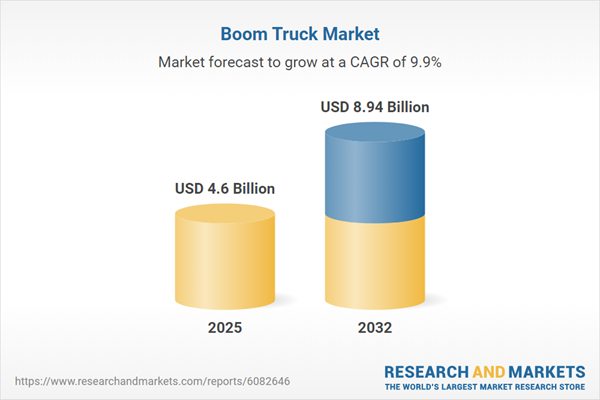Speak directly to the analyst to clarify any post sales queries you may have.
The boom truck market is undergoing sharp transformation as the demand for safer, more efficient, and technologically advanced material handling solutions accelerates. Senior leaders seeking a competitive edge recognize that next-generation boom truck technologies are pivotal to enhancing workflow reliability, ensuring regulatory compliance, and managing operational risks across evolving industries.
Market Snapshot: Boom Truck Market Growth and Outlook
The global boom truck market shows significant growth momentum. Rising from USD 4.19 billion in 2024 to an anticipated USD 4.60 billion in 2025, it is forecast to reach USD 8.94 billion by 2032, maintaining a robust 9.92% compound annual growth rate. Expansion is propelled by ongoing infrastructure upgrades, increased capital flows in construction, energy, and heavy industry, and rapid adaptation to changing project priorities. Organizations across these sectors demand lifting solutions designed for both flexibility and regulatory agility, reinforcing the importance of reliable, compliant equipment for mission-critical operations.
Boom Truck Market Scope & Segmentation
- Application: Covers a broad range of use cases, including commercial, infrastructure, and residential construction, bridge and roadwork, tunneling, various mining environments, as well as all phases of oil and gas field operations. Each sector requires different boom truck features and safety enhancements, driving customization and influencing purchase decisions.
- Lifting Capacity: Offers models in ≤5 Ton, 5–10 Ton, and >10 Ton categories. These cater to varied project workloads, giving managers precise options for handling project-specific material demands and optimizing job site efficiency.
- Boom Type: Includes both articulating and telescopic models, providing adaptability for confined urban zones or expansive industrial projects. This diversity enables operators to match truck configurations to distinct operational tasks and space constraints.
- Propulsion: Diesel powertrains remain foundational, while new electric variants address sustainability requirements and environmental mandates. This dual offering supports alignment with emissions standards and future-proofs fleet investments.
- End User: Constituted by major segments such as construction and infrastructure contractors, energy utilities, and specialized rental firms. These stakeholders each influence feature innovations, after-sales support models, and service expectations within their industries.
- Regional Coverage: Encompasses key markets across the Americas (United States, Canada, Mexico, major Latin American countries), Europe, Middle East & Africa, and Asia-Pacific. High-growth economies including China, India, and Japan exhibit distinct adoption patterns and infrastructural agendas, directly impacting product strategies and market penetration efforts.
- Key Companies: The landscape consists of established multinational leaders and agile regional players. Notable names include Liebherr-International AG, The Manitowoc Company, Inc., Terex Corporation, Tadano Ltd., Xuzhou Construction Machinery Group Co., Ltd., Sany Heavy Industry Co., Ltd., Zoomlion Heavy Industry Science & Technology Co., Ltd., Palfinger AG, Kato Works Co., Ltd., and Manitex International, Inc. Diverse portfolios and continuous R&D lend competitive differentiation across regions.
Boom Truck Market: Key Takeaways for Decision Makers
- Telematics and automation have become central to maximizing equipment uptime, delivering improved lifecycle value, and lowering direct maintenance expenditures through predictive insights.
- Advanced monitoring systems and fail-safe controls reinforce safety cultures and help organizations remain compliant with changing regulations and industry standards.
- Adoption of hybrid and electric propulsion is expanding, allowing firms to proactively meet regulatory changes and address client sustainability requirements in procurement processes.
- Supply chains are being strategically restructured to reduce risk and increase operational resilience through local sourcing and diversified vendor bases.
- Rental fleet operators are gaining market influence, steering specifications, and requiring enhanced product innovation and after-sales responsiveness from OEMs.
- Growing demand for modular, customizable solutions enables organizations to adapt faster to worksite-specific needs—vital for sectors like mining, construction, and oil and gas where versatility ensures project continuity.
Tariff Impact and Supply Chain Strategies
- Escalating tariffs on key components are prompting manufacturers to pursue locally sourced parts and in-region assembly, ensuring greater pricing consistency and delivery reliability.
- Strengthening supplier partnerships and flexible logistics arrangements allow stakeholders to swiftly adjust to demand shifts and safeguard against market instability.
- Tactical investment in value engineering and partial vertical integration is building supply chain resilience, supporting competitive positions amid regularly shifting material and freight costs.
Methodology & Data Sources
Findings in this boom truck market report result from in-depth executive interviews, combined with proprietary and public data analyses. The study cross-verified multiple perspectives to identify shared industry drivers, with scenario-based models supporting technology adoption forecasts and future market sizing.
Why This Report Matters
- Empowers leadership teams with benchmarks to realign strategies as market frameworks, regulations, and competitive dynamics evolve in the boom truck sector.
- Delivers actionable, risk-weighted intelligence for capital planning, fleet upgrades, and expansion into both established and emerging regions, based on segmentation and trend analysis.
- Streamlines the evaluation of growth avenues by offering clear segmentation and insight into customer requirements—critical for efficient resource allocation and market entry decisions.
Conclusion
The boom truck market is advancing alongside technology, compliance, and supply chain optimization. Proactive leadership today can leverage these changes to navigate market challenges and unlock new opportunities as sector dynamics continue to evolve.
Table of Contents
3. Executive Summary
4. Market Overview
7. Cumulative Impact of Artificial Intelligence 2025
Companies Mentioned
The companies profiled in this Boom Truck market report include:- Liebherr-International AG
- The Manitowoc Company, Inc.
- Terex Corporation
- Tadano Ltd.
- Xuzhou Construction Machinery Group Co., Ltd.
- Sany Heavy Industry Co., Ltd.
- Zoomlion Heavy Industry Science & Technology Co., Ltd.
- Palfinger AG
- Kato Works Co., Ltd.
- Manitex International, Inc.
Table Information
| Report Attribute | Details |
|---|---|
| No. of Pages | 197 |
| Published | October 2025 |
| Forecast Period | 2025 - 2032 |
| Estimated Market Value ( USD | $ 4.6 Billion |
| Forecasted Market Value ( USD | $ 8.94 Billion |
| Compound Annual Growth Rate | 9.9% |
| Regions Covered | Global |
| No. of Companies Mentioned | 11 |









